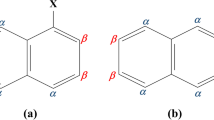Abstract
This work compares the performance of theoretical methods and basis sets on the molecular structure, atomisation and ionisation energies, electron affinity, and vibrational spectrum of silylene. Silylene, its cation and anion have been studied in 1 A 1, 2 A 1 and 2 B 1 states, respectively, in the gas phase and C2v symmetry. The methods considered are second-order Møller-Plesset perturbation theory (MP2), the density functional theory (DFT), Gaussian-2 (G2) and complete basis set methods (CBS-4M and CBS-Q). The basis sets used are 6-31G(d,p), 6-311G(d,p), 6-31++G(d,p) and 6-311++G(d,p). The functional used for the DFT method is B3LYP. Silylene and its cation and anion have been optimised using the MP2 and DFT methods and the named basis sets. Single-point energy calculations (G2, CBS-4M and CBS-Q) were performed using MP2/6-311++G(d,p) structures and these energies have been used to calculate atomisation energy, ionisation energy and adiabatic electron affinity. Frequency calculations were also done and the raw vibrational frequencies were assigned. It is interesting to note the close similarity between the predicted parameters and some of the available literature values. The results obtained are consistent and converge with different basis sets with improved size and quality. However, the parameters obtained are very much method dependent.
Similar content being viewed by others
References
Lickiss PD (1994) In: King RB (ed) Encyclopedia of inorganic chemistry, vol 7. Wiley, Chichester, p 3770
Ignacio EW, Schlegel HB (1990) J Phys Chem 94:7439
Kasdan A, Herbst E (1975) J Chem Phys 62:541
Nimlos MR, Barney EG (1986) J Am Chem Soc 108:6522
Boo BH, Armentrout PB (1987) J Am Chem Soc 109:3549
Yamada C, Kanamori H, Hirota E, Nishiwaki N, Itabashi N, Kato K, Goto T (1989) J Chem Phys 91:4582
Michels HH, Hobbs RH (1993) Chem Phys 207:389
Allen WD, Schaefer III HF (1986) Chem Phys 108:243
Feller D, Dixon DA (1999) J Phys Chem A 103:6413
Pak C, Rienstra-Kiracofe JC, Schaefer III HF (2000) J Phys Chem A 104:11232
Malcolm NOJ, Yeager DL (2000) J Chem Phys 113:8
Ikuta S, Wakamatsu S (2004) J Chem Phys 120:11071
Wong His-Wu, Nieto JCA, Swihart MT, Broadbelt LJ (2004) J Phys Chem A 108:874
Larkin DL, Schaefer III HF (2004) J Chem Phys 121:9361
Helgaker T, Jørgensen P, Olsen J (2000) Molecular electronic-structure theory, Wiley, Chichester
Gaussian 03, Revision C.02 (2004) Frisch MJ et al. Gaussian, Inc., Wallingford, CT
GaussView, Version 3.09 (2003) Dennington R II, Keith T, Millam J, Eppinnett K, Hovell WL, Gilliland R, Semichem Inc., Shawnee Mission, KS
Møller C, Plesset MS (1934) Phy Rev 46:622
Head-Gordon M, Pople JA, Frisch MJ (1988) Chem Phys Lett 153:503
Frisch MJ, Head-Gordon M, Pople JA (1990) Chem Phys Lett 166:275
Frisch MJ, Head-Gordon M, Pople JA (1990) Chem Phys Lett 166:281
Head-Gordon M, Head-Gordon T (1994) Chem Phys Lett 220:122
Saebo S, Almlof J (1989) Chem Phys Lett 154:83
Hohenberg P, Kohn W (1964) Phys Rev 136:B864
Kohn W, Sham LJ (1965) Phys Rev 140:A1133
Stephens PJ, Devlin FJ, Chabalowski CF, Frisch MJ (1994) J Phys Chem 98:11623
Francl MM, Petro WJ, Hehre WJ, Binkley JS, Gordon MS, DeFrees DJ, Pople JA (1982) J Chem Phys 77:3654
McLean AD, Chandler GS (1980) J Chem Phys 72:5639
Clark T, Chandrasekhar J, Spitznagel GW, Schleyer PvR (1983) J Comp Chem 4:294
Curtiss LA, Raghavachari K, Pople JA (1993) J Chem Phys 98:1293
Ochtersk JW, Petersson GA, Montgomery Jr JA (1996) J Chem Phys 104:2598
Montgomery Jr JA, Frisch MJ, Ochterski JW, Petersson GA (2000) J Chem Phys 112:6532
Petersson GA, Tensfeldt TG, Montgomery Jr JA (1991) J Chem Phys 94:6091
Gupte GR, Prasad R (1998) Int J Mod Phys B 12:1607
Hirota E, Ishikawa H (1999) J Chem Phys 110:4254
Kasdan A, Herbst E, Lineberger WC (1975) J Chem Phys 62:541
Andrews L, Wang X (2002) J Phys Chem A 106:7696
Author information
Authors and Affiliations
Corresponding author
Rights and permissions
About this article
Cite this article
Kinoo, F.S., Ramasami, P. Performance of theoretical methods and basis sets on the molecular structure, atomisation and ionisation energies, electron affinity, and vibrational spectrum of silylene. Silicon Chem 3, 251–257 (2007). https://doi.org/10.1007/s11201-007-9027-x
Received:
Accepted:
Published:
Issue Date:
DOI: https://doi.org/10.1007/s11201-007-9027-x




